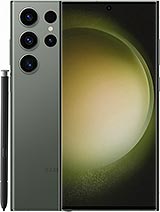Introduction
For a while there, we weren't willing to get our hopes up that there would be a global Xiaomi Ultra again - the 2021 model could very well have remained a one-off to remember fondly. Then at one point, we were led to believe that not only was there not going to be a global one, there wasn't going to be one at all. Well, in the end, it all worked out nicely, and we now have the Xiaomi 13 Ultra - one for China and one for the world.

With that said, we still have to point out that Xiaomi sent us a version of the handset running China-specific software. So, while theoretically, a global variant is supposed to be available at one time or another, we haven't yet touched or seen it. For the purposes of this review, however, that's largely inconsequential.
That's in part because what's most important about the 13 Ultra transcends regional software specifics. We're talking about the one-of-a-kind quad-camera setup on the back of the handset. And you know it's something special when the 50MP 1-inch main unit - undisputedly the headliner of the bunch, is joined by a couple of telephotos and an ultrawide, each of them with a 50MP sensor of its own. We look forward to starting this camera section with both excitement and apprehension. But all in due time.
There's a smartphone strapped to that Leica-co-engineered marvel of a camera system, and it's a proper high-end one too. The latest Snapdragon, a cutting-edge high-res, high-refresh-rate OLED display, dust and water resistance, and fast charging - finding something to complain about on the following pages is going to be tough. Initially, looking at the pictures, we thought the design would be that, but after experiencing the handset in person, the looks of it have grown on us too.
Here's a quick summary of the more important specs before we get going.
Xiaomi 13 Ultra specs at a glance:
- Body: 163.2x74.6x9.1mm, 227g; Glass front (Gorilla Glass Victus), eco-leather back, aluminum frame; IP68 dust/water resistant (up to 1.5m for 30 min).
- Display: 6.73" LTPO AMOLED, 1B colors, 120Hz, Dolby Vision, HDR10+, 1300 nits (HBM), 2600 nits (peak), 1440x3200px resolution, 20:9 aspect ratio, 522ppi.
- Chipset: Qualcomm SM8550-AB Snapdragon 8 Gen 2 (4 nm): Octa-core (1x3.2 GHz Cortex-X3 & 2x2.8 GHz Cortex-A715 & 2x2.8 GHz Cortex-A710 & 3x2.0 GHz Cortex-A510); Adreno 740.
- Memory: 256GB 12GB RAM, 512GB 16GB RAM, 1TB 16GB RAM; UFS 4.0.
- OS/Software: Android 13, MIUI 14.
- Rear camera: Wide (main): 50 MP, f/1.9 or f/4.0, 23mm, 1.0"-type, 1.6µm, multi-directional PDAF, Laser AF, OIS; Ultra wide angle: 50 MP, f/1.8, 12mm, 122˚, 1/2.51", Dual-Pixel PDAF; Telephoto: 50 MP, f/1.8, 75mm, 1/2.51", Dual-Pixel PDAF, OIS, 3.2x optical zoom; Telephoto: 50 MP, f/3.0, 120mm, 1/2.51", Dual-Pixel PDAF, OIS, 5x optical zoom; Wide (main): 50 MP, f/1.9 or f/4.0, 23mm, 1.0"-type, 1.6µm, multi-directional PDAF, Laser AF, OIS.
- Front camera: 32 MP, f/2.0, 22mm (wide), 0.7µm.
- Video capture: Rear camera: 8K@24fps, 4K@24/30/60fps, 1080p@30/60/120/240/480/960/1920fps, gyro-EIS, Dolby Vision HDR 10-bit rec. (4K@60fps, 1080p); Front camera: 1080p@30/60fps.
- Battery: 5000mAh; 90W wired, PD3.0, QC4, 100% in 35 min (advertised), 50W wireless, 100% in 49 min (advertised), 10W reverse wireless.
- Connectivity: 5G; Dual SIM; Wi-Fi 6e; BT 5.3, aptX HD, aptX Adaptive; NFC; Infrared port.
- Misc: Fingerprint reader (under display, optical); stereo speakers.
Xiaomi 13 Ultra unboxing
The 13 Ultra's presentation is no different than that of any recent Xiaomi Pro or Ultra. The black color is all that sets it apart from the lesser models in the lineup, and the red Leica dot is a lone splash of color on the cardboard.

Inside, you'll find the phone, a 90W power adapter, and a USB-A-to-C cable to go with it. Also included is a black snap-on case that doesn't quite live up to the standard of the Ultra itself, though its utility shouldn't be affected by its less-than-premium appearance.

What you won't find inside the regular retail package is the Xiaomi 13 Ultra Professional Camera Bundle, which can be purchased separately in China for CNY 1000 (€130). The kit includes a nicer phone case, a separate right-hand grip, a filter adapter ring that lets you screw on standard 67mm lens filters, a lens cap (or, rather, a whole camera system cap in this case), and a lanyard.
The whole thing makes the Ultra look even less like a phone and more like a compact camera, and the hand grip makes it behave like one, too, thanks to its two-stage shutter release button and a zoom rocker. Unfortunately, we didn't have the opportunity to play with this set of accessories.

Design, build quality, handling
Fitting cutting-edge camera hardware on a smartphone is never going to make for a subtle rear-end appearance and previous Xiaomi Ultras have been anything but... incognito. But they've always owned it and made the large camera assemblies appealing in their own particular way.
We weren't so sure about the 13 Ultra when we saw the initial renders, though. After all, its camera bump has a camera bump!

But in reality, things are nowhere as bad. Not at all bad, actually. If anything, the sort of ramp that leads up to the huge circular camera assembly helps create a smoother transition from smartphone thickness to camera thickness, so to speak.

While the specs read 9.1mm (measured at the thin end, obviously), our calipers said 9.3mm. The thickness at the Leica end, on the other hand, is 15.2mm - so a camera protruding nearly 6mm would have been quite the eyesore, not to mention potentially impair handling (and out-of-pocket-pulling). The ramp is most welcome then.

Co-engineered with the German optics specialists, the cameras are clustered together under a common glass circle measuring 55mm in diameter. It's a couple of millimeters larger than that of the 12S Ultra and placed just a bit lower on the back of the phone.
Things have been moved around inside since there's one extra camera now and the center is now home to the Leica logo. Previously, the ultrawide camera went in there.
 The Xiaomi 12S Ultra (left) next to the 13 Ultra
The Xiaomi 12S Ultra (left) next to the 13 Ultra
The new ultrawide's location in the top right corner of the cluster places it closer to the edge of the phone. We had more than one instance where we got fingers blocking the corner of the frame when taking pictures in landscape orientation and holding the phone with both hands. It's worth keeping an eye out for that.
 That left middle finger is definitely within the ultrawide's frame
That left middle finger is definitely within the ultrawide's frame
The rear panel of the 13 Ultra is made of man-made leather (so not 'real' leather), and it's one of the best implementations of the material that we've fondled. On par with the 12 Ultra's tactile experience, the 13 Ultra's leather-like back feels soft and grippy and it's that extra bit better than competing efforts from Oppo or vivo.

Our review unit is in the Olive Green hero colorway which is unlike any other out there, but also understated as opposed to in-your-face. The brass-looking ring around the camera housing could have been a shade of green too, but perhaps it serves well to add a splash of color as it is. Two more body color options are also available, and you can't really go wrong with the classics - Black and White. I all cases, the ring remains the same color.

Somewhat unusually, the rear panel doesn't go all the way to the side edges - it's the aluminum frame that curves inwards to meet it, instead. More exposed metal is more premium, no?
The frame is color-matched to the back panel from colorway to colorway and gets a satin finish. The symmetrical placement of the strips that divide it and enable it to serve as antennas is a nice touch for those who appreciate attention to detail.

Those same folks perhaps won't be thrilled to find out that the speaker 'grilles' in the frame are made up of four circular openings instead of the cool wavy design of the 13 Pro or the 11 Ultra. Then again, the 12S Ultra already abandoned that for the more serious look of identical circles, it's just that there are fewer of them here than on the last gen.
In addition to the speaker outlets on top, there's also an infrared emitter, as usual, plus two mic pinholes. Another set of speaker holes is on the bottom, joined by a mic and the SIM card slot (dual nano, no microSD). The gasket on the card tray hints at water resistance and the specsheet confirms it with an official IP68 rating.
The flat sides are a boon for hand-holding as they provide ample gripping area, and picking up the 13 Ultra from a table doesn't require any special approaches. There's also the matter that the camera bump raises it significantly from the surface so it's not just the flat rails - it's a joint effort.

The 13 Ultra's physical controls are on the right - power button around the middle, volume rocker above it. As expected they all have a very solid clicking action, and they're metal too.

Sort of a 'physical' control is the fingerprint reader underneath the display. The optical sensor is placed at just the right height - not too low, not too high, and operates with the speed and consistency you'd expect at this level.

Yes, it's only now that we get to the display side of the handset, but it's just that there's so much character everywhere else. That's not to say that we're not loving the Ultra's 6.73-inch OLED screen - quite the opposite.
Minimal bezels all around and the faintest of curves that the Gorilla Glass Victus makes towards the sides deliver a premium look and feel that's worthy of... well, whatever price Xiaomi comes up with, really.

Part of that posh impression the Ultra leaves can also be attributed to the phone's weight - or rather, the perception of density you get when holding it. At 227g, it weighs a few grams less than a Galaxy S23 Ultra (234g) or an iPhone 14 Pro Max (240g), so it's hardly the heaviest of its peers. The Find X6 Pro is slightly lighter, and so too are the vivo X90 Pros.

It is, of course, a full-size smartphone, so if you're after a compact solution, you should probably look elsewhere. But quad-cam setups with a 1-inch main unit haven't been known to come in overly pocketable phones, no.
To sum it all up, the Xiaomi 13 Ultra won us with its design despite our early skepticism. It's handsome to look at in the flesh, it handles well and it feels expensive.

6.73 inches of OLED greatness
The Xiaomi 13 Ultra is equipped with a 6.73-inch OLED display that's all sorts of great. With a 1,440x3,200px resolution, a 120Hz adaptive refresh rate, 1920Hz PWM dimming, and Dolby Vision support, there's really nothing missing on this one.

When it comes to brightness, the 13 Ultra was good for just over 1,200nits in adaptive brightness mode - some 100nits lower than the Find X6 Pro and a few dozen less than the Galaxy S23, but let's face it - 1207nits isn't going to have anyone complaining. Admittedly, the iPhone can go way brighter, though one has to wonder how much is enough, and how much is too much.
With around 500nits available on the slider without the sun blasting at its ambient light sensor, the Xiaomi falls into the 'regular' category, so to speak. Some phones let you access around 800nits manually - the iPhone, of course, but also the Find, the Galaxy, and even the Magic. Again, it hard to call out the Xiaomi for being inadequate in terms of brightness with its 500/1200 results, it's just that there are proper overachievers amongst its rivals.
Color accuracy
The 13 Ultra has the familiar Xiaomi color settings menu, but with a twist. The Original color mode is now PRO, and it's the default mode as opposed to the usual Vivid. The latter is also present, of course, as is Saturated mode, and three extra ones under the Advanced settings submenu.
We won't be surprised if this arrangement is limited to the Chinese software version and the global one ends up with a 'non-PRO' Original color mode and Vivid is the default - as was the case on the China-only 12S Ultra and as is the case on the international 13 Pro.

Anyway, Original color PRO mode returns okay results for sRGB test swatches (it's not a wide-gamut mode) with the usual bluish whites and grays. Switch to the Warm temperature preset, however, and you'd get an essentially perfect sRGB rendition - we measured an average dE2000 of 0.6 (!).
Vivid mode (targeting DCI-P3) was similarly off in its default state, and the Warm temp preset only partially fixed things. Setting a custom point on the color wheel high in the yellows got us to an average dE2000 of under 2.0, which is also impressive. We wish Xiaomi had calibrated that well the screen at the factor.
As we've experienced before, the named sRGB and P3 modes in the Advanced settings menu didn't get us accurate readings for the respective color swatches.
Refresh rate and resolution
Similarly to other recent Xiaomis with 1440p screens, the 13 Ultra lets you choose whether the phone should render in its native resolution or a lower 1080p, the presumption being that the lower-res setting would be less taxing on the battery and in graphics-intensive tasks. When you're in 1440p mode, there's also a toggle that allows the phone to automatically switch down to 1080p when it decides it's appropriate.
The display supports up to 120Hz refresh rate, and there are two refresh modes - Custom (choose between 120Hz or 60Hz refresh ceilings), and Default (automatic switching behavior).

The adaptive refresh rate works as expected - it drops down to 1Hz when the screen shows static content and can be incredibly dynamic (constantly changing between 10Hz and 120Hz with no fixed steps) in games or browsers. The few scenarios where we saw it go for fixed refresh rates, besides 1Hz for static picture, were 24Hz for 24fps videos, 30Hz for 30fps clips, and 60Hz for HFR clips and apps, which are incompatible with dynamic refresh rate adjustments.
The always-on display uses 30Hz, and on a couple of occasions, we saw static content display at 10Hz - as we mentioned, the screen is indeed as dynamic as it can be these days.
There is a twist, though. The minimum refresh rate depends on the screen brightness. If the brightness is below 100nits or so, the refresh rate will be kept at maximum (60Hz or 120Hz), depending on the occasion, and the only time it will drop below these maximums is for specific video fps (24 or 30 fps).
On the positive side, the display supports high-frequency 1920Hz PWM dimming so it shouldn't bother anyone sensitive to the usual low-frequency PWM brightness control on OLED screens.
HDR and streaming
The Xiaomi 13 Ultra comes with Widevine L1 DRM support, and Full HD streaming with HDR10/10+ and Dolby Vision support is available across popular platforms. Our review unit being the Chinese version, it doesn't get HDR in Netflix, though if the global 13 Pro is any indication, the global 13 Ultra should have it eventually.
Xiaomi 13 Ultra battery life
The 13 Ultra has a 5,000mAh power pack inside, as do most of its competitors. It's sort of an upgrade over the 12S Ultra's 4,860mAh number, which in turn was sort of a downgrade from the 11 Ultra's 5,000mAh capacity.
The phone returned respectable numbers in all of our tests and showed improvement across the board over the previous generation.
The 15:29h web-browsing result is a bit below the average for the class, while the 19:13h we got while looping videos is on par with the Find X6 Pro, and better than the vivo X90 Pro, if not quite as good as the Galaxy.
The voice call longevity was a few hours shorter than the Galaxy's, but better than most, at 36:31h.
All in all, the Xiaomi 13 Ultra earned an Endurance rating of 108h.

Our battery tests were automated thanks to SmartViser, using its viSerDevice app. The endurance rating denotes how long the battery charge will last you if you use the device for an hour of telephony, web browsing, and video playback daily. More details can be found here.
Video test carried out in 60Hz refresh rate mode whenever possible. Web browsing is carried out at the display's highest refresh rate whenever possible. Refer to the respective reviews for specifics. To adjust the endurance rating formula to match your own usage - check out our all-time battery test results chart.
Charging speed
The 13 Ultra supports USB PowerDelivery 3.0 and Qualcomm QuickCharge 4.0 and is rated for charging at up to 90W. That's also what it says on the included charger. In our testing, the power meter maxed out at around 77W, and we'd say that's close enough.

Xiaomi says the 13 Ultra should charge from flat to full in 35 minutes, while we measured that to take 40 minutes - perhaps their number is achieved when the phone is turned off, while we test with the device switched on. We were looking at 91% at the half-hour mark.
In any case, the results are what you could call average when it comes to fast charging in the high-end class. Big-name Chinese competitors are quicker, as is Xiaomi's own 13 Pro, while Galaxies and iPhones are slower - nothing new, really.
The 13 Ultra supports wireless charging, both in and out, but there's no listing for it on WPC's site (not that those are overly informative). Xiaomi says the phone can be charged wirelessly at up to 50W and should reach 100% in 49 minutes, but we haven't been able to test that.
In the other direction, the phone is specced to be able to output up to 10W so you could easily recharge a wearable or TWS headphone case if they support standard Qi wireless charging.
Speakers
The Xiaomi 13 Ultra has a stereo speaker setup with one driver firing out the bottom, and another one at the top directing sound both forward through the earpiece and out through a grille on the top plate. There's no Harman/Kardon branding like there was on Ultras past, but there's still Dolby Atmos support.
The top speaker gets the left channel in vertical orientation, and channels are switched to match the landscape orientation. The two speakers each output their respective channel, but also an attenuated version of the opposite channel - you get the stereo separation alright and a guarantee you won't be missing anything in case you completely block one speaker with your hands.



Bottom speaker • Top speaker • Earpiece
In our testing, the 13 Ultra earned a 'Very Good' rating for loudness, essentially on par with all the high-end competition. It sounds a whole lot like the 12S Ultra, and that's no bad thing - we're getting balanced output with solid low-end thump, pleasing vocals and well-defined treble. It's one of the best speaker experiences you can get.
Mind you, that's in the default state, with Dolby Atmos turned on. Switching it off results in a noticeably toned down low-frequency response.
Use the Playback controls to listen to the phone sample recordings (best use headphones). We measure the average loudness of the speakers in LUFS. A lower absolute value means a louder sound. A look at the frequency response chart will tell you how far off the ideal "0db" flat line is the reproduction of the bass, treble, and mid frequencies. You can add more phones to compare how they differ. The scores and ratings are not comparable with our older loudspeaker test. Learn more about how we test here.
MIUI 14 on Android 13
The Xiaomi 13 Ultra runs MIUI 14 based on an Android 13 core. That's the latest you can get on a Xiaomi phone, so the Ultra is receiving the flagship treatment as expected. It's a software package we already experienced on the 13 Pro, so there are not a whole lot of surprises either.

Our review unit is the Chinese version, so it's running the software that's specific to that locale, and that means some features differ from what the global branch is getting. Normally, if it's a China-only release, we'd go over the phone's software as is - that's what we did on the 12S Ultra last year.
In this particular case, however, we're in somewhat of a predicament since we know the 13 Ultra will be getting a global release with global software - eventually. So instead of going over the user interface of our review unit, we'd direct your attention to the 13 Pro's review to get a better taste of what to expect.

On top of that, there's also a dedicated detailed MIUI 14 on Android 13 walkthrough we just put together. In addition to showcasing Xiaomi's latest software, it outlines some of the differences between the Chinese and global versions, so it's going to be more informative than looking at our 13 Ultra in isolation.
Performance and benchmarks
Surprising no one, the Xiaomi 13 Ultra is powered by the Snapdragon 8 Gen 2 - Qualcomm's high-end chipset for 2023. It's the SoC we saw in the 13 Pro, as well as the Galaxy S23 Ultra, Find X6 Pro, OnePlus 11, and many others.

You've probably already read this before - in the above reviews, no less, but the SD 8 Gen 2 has an octa-core processor with one prime core, four performance ones (further subdivided into 2+2), and three cores for less demanding applications, so it's a 1+2+2+3 setup. Or for completeness' sake - 1x3.2GHz Cortex-X3 + 2x2.8 GHz Cortex-A715 & 2x2.8GHz Cortex-A710 & 3x2.0GHz Cortex-A510 CPU cores.
The Gen 2 chipset offers 35% higher performance and 40% improved efficiency in the CPU department over the previous Gen and 25% and 45% performance and efficiency bumps on the GPU side of things (which goes by Adreno 740). It also has support for new, faster memory technologies (LPDDR5X and UFS 4.0). That's nice and all, but since you're likely comparing the latest phones to their equally latest rivals, those differences aren't all that important since most current top-tier devices have the same chip inside.
The Xiaomi 13 Ultra exists in three memory configurations - 12GB/256GB, 16GB/512GB (our review unit), and 16GB/1TB.

Starting our usual benchmarking routine with GeekBench, we're seeing that the 13 Ultra is a top performer under both single-core and multi-core loads. The differences aren't huge, but it's nice to see your phone towards the top of the charts.
GeekBench 6 (single-core)
Higher is better
- Xiaomi 13 Ultra
2000 - Motorola Edge 40 Pro
1996 - Xiaomi 13 Pro
1987 - Honor Magic5 Pro
1943 - Galaxy S23 Ultra
1913 - ROG Phone 7
1857 - ROG Phone 7 Ultimate
1756 - Oppo Find X6 Pro
1532 - OnePlus 11
1527
GeekBench 6 (multi-core)
Higher is better
- Xiaomi 13 Ultra
5556 - Motorola Edge 40 Pro
5352 - Xiaomi 13 Pro
5323 - ROG Phone 7
5254 - Honor Magic5 Pro
5096 - ROG Phone 7 Ultimate
5085 - Oppo Find X6 Pro
5082 - Galaxy S23 Ultra
5077 - OnePlus 11
5043
GeekBench 5 (single-core)
Higher is better
- Galaxy S23 Ultra
1537 - Xiaomi 13 Pro
1490 - Motorola Edge 40 Pro
1482 - iQOO 11
1479 - Xiaomi 13 Ultra
1477 - ROG Phone 7
1397 - vivo X90 Pro
1387 - ROG Phone 7 Ultimate
1359 - Xiaomi 12S Ultra
1324 - Oppo Find X6 Pro
1166 - OnePlus 11
1150 - Honor Magic5 Pro
1130
GeekBench 5 (multi-core)
Higher is better
- Xiaomi 13 Pro
5087 - Xiaomi 13 Ultra
5049 - ROG Phone 7
4935 - Galaxy S23 Ultra
4927 - OnePlus 11
4899 - Motorola Edge 40 Pro
4896 - ROG Phone 7 Ultimate
4832 - iQOO 11
4803 - Oppo Find X6 Pro
4759 - Honor Magic5 Pro
4378 - Xiaomi 12S Ultra
4300 - vivo X90 Pro
4273
In an even more tightly spaced Antutu chart, the Xiaomi 13 Ultra does yield to the Find, but still manages to stay ahead of the Galaxy and the vivo.
AnTuTu 9
Higher is better
- Oppo Find X6 Pro
1294797 - Xiaomi 13 Pro
1281666 - iQOO 11
1281665 - ROG Phone 7
1279196 - Motorola Edge 40 Pro
1273764 - iQOO 11 (1080p)
1272973 - Xiaomi 13 Ultra
1268538 - Galaxy S23 Ultra
1241531 - vivo X90 Pro
1228735 - ROG Phone 7 Ultimate
1218533 - OnePlus 11
1140661 - Xiaomi 12S Ultra
1039412
Going into the graphics benchmarks, nothing really changes - even in such a tough crowd, the Xiaomi 13 Ultra manages to either be on top, or right up there with the best.
GFX Aztek ES 3.1 High (offscreen 1440p)
Higher is better
- Xiaomi 13 Ultra
62 - iQOO 11
62 - Xiaomi 13 Pro
61 - Oppo Find X6 Pro
61 - OnePlus 11
61 - Motorola Edge 40 Pro
60 - Galaxy S23 Ultra
59 - ROG Phone 7 Ultimate
56 - vivo X90 Pro
55 - ROG Phone 7
52 - Xiaomi 12S Ultra
46
GFX Aztek Vulkan High (offscreen 1440p)
Higher is better
- Xiaomi 13 Ultra
69 - Galaxy S23 Ultra
69 - iQOO 11
69 - Oppo Find X6 Pro
68 - OnePlus 11
68 - Motorola Edge 40 Pro
68 - Xiaomi 13 Pro
67 - ROG Phone 7 Ultimate
58 - ROG Phone 7
55 - vivo X90 Pro
54 - Xiaomi 12S Ultra
51
GFX Car Chase ES 3.1 (offscreen 1080p)
Higher is better
- Xiaomi 13 Ultra
129 - iQOO 11
128 - Xiaomi 13 Pro
127 - Motorola Edge 40 Pro
127 - ROG Phone 7 Ultimate
127 - Galaxy S23 Ultra
126 - Oppo Find X6 Pro
126 - OnePlus 11
126 - ROG Phone 7
125 - vivo X90 Pro
105 - Xiaomi 12S Ultra
104
GFX Manhattan ES 3.1 (offscreen 1080p)
Higher is better
- Xiaomi 13 Ultra
224 - Xiaomi 13 Pro
222 - iQOO 11
222 - Oppo Find X6 Pro
220 - OnePlus 11
220 - Motorola Edge 40 Pro
220 - ROG Phone 7 Ultimate
214 - Galaxy S23 Ultra
212 - vivo X90 Pro
200 - ROG Phone 7
194 - Xiaomi 12S Ultra
182
GFX Aztek ES 3.1 High (onscreen)
Higher is better
- Galaxy S23 Ultra (1080p)
89 - iQOO 11 (1080p)
89 - Motorola Edge 40 Pro
86 - Xiaomi 13 Ultra (1080p)
85 - vivo X90 Pro (1080p)
83 - ROG Phone 7 Ultimate
83 - ROG Phone 7
81 - vivo X90 Pro
65 - Galaxy S23 Ultra
54 - iQOO 11
54 - Xiaomi 13 Ultra
51 - Oppo Find X6 Pro
51 - Xiaomi 13 Pro
49 - OnePlus 11
49 - Xiaomi 12S Ultra
38
GFX Aztek Vulkan High (onscreen)
Higher is better
- Motorola Edge 40 Pro
98 - Galaxy S23 Ultra (1080p)
97 - Xiaomi 13 Ultra (1080p)
95 - iQOO 11 (1080p)
91 - vivo X90 Pro (1080p)
82 - ROG Phone 7 Ultimate
78 - ROG Phone 7
74 - vivo X90 Pro
68 - Galaxy S23 Ultra
60 - Oppo Find X6 Pro
56 - Xiaomi 13 Ultra
55 - iQOO 11
55 - OnePlus 11
53 - Xiaomi 13 Pro
52 - Xiaomi 12S Ultra
39
GFX Car Chase ES 3.1 (onscreen)
Higher is better
- Motorola Edge 40 Pro
112 - Xiaomi 13 Ultra (1080p)
110 - Galaxy S23 Ultra (1080p)
110 - iQOO 11 (1080p)
110 - ROG Phone 7
107 - ROG Phone 7 Ultimate
107 - vivo X90 Pro (1080p)
93 - vivo X90 Pro
74 - Galaxy S23 Ultra
67 - iQOO 11
67 - Xiaomi 13 Pro
64 - Xiaomi 13 Ultra
63 - Oppo Find X6 Pro
60 - OnePlus 11
57 - Xiaomi 12S Ultra
51
GFX Manhattan ES 3.1 (onscreen)
Higher is better
- Motorola Edge 40 Pro
164 - ROG Phone 7 Ultimate
162 - ROG Phone 7
157 - Xiaomi 13 Ultra (1080p)
120 - Galaxy S23 Ultra (1080p)
120 - iQOO 11 (1080p)
120 - vivo X90 Pro (1080p)
120 - vivo X90 Pro
118 - Galaxy S23 Ultra
112 - iQOO 11
112 - Xiaomi 13 Ultra
108 - Xiaomi 13 Pro
103 - Xiaomi 12S Ultra
91 - Oppo Find X6 Pro
60 - OnePlus 11
60
3DMark Wild Life Vulkan 1.1 (offscreen 1440p)
Higher is better
- Oppo Find X6 Pro
13360 - vivo X90 Pro
13265 - Xiaomi 13 Ultra
13106 - iQOO 11
12738 - Galaxy S23 Ultra
12241 - Motorola Edge 40 Pro
12230 - Xiaomi 12S Ultra
10533 - Xiaomi 13 Pro
10289
3DMark Wild Life Extreme (offscreen 1440p)
Higher is better
- Galaxy S23 Ultra
3790 - Xiaomi 13 Ultra
3750 - ROG Phone 7
3745 - vivo X90 Pro
3698 - Oppo Find X6 Pro
3696 - Honor Magic5 Pro
3684 - Motorola Edge 40 Pro
3660 - ROG Phone 7 Ultimate
3656 - OnePlus 11
3594 - iQOO 11
3514 - Xiaomi 13 Pro
2939
With those high marks in all the benchmarks, you'd think that the 13 Ultra is good for a fast run or two, but it wouldn't be too fond of prolonged loads. In fact, it exhibited impressive stability in both the one-hour CPU throttling test and the 20-minute Wild Life stress tests in 3D Mark.



CPU throttling test • 3DMark Wild life stress test
Xiaomi has employed what they call a Loop LiquidCool technology (also dubbed Mi IceLoop) - the 'first landing of an aerospace-grade large toroidal cooling system on a smartphone'. It has a slit in the middle, which separates the channel with the hot vapor escaping from the SoC from the return channel with the condensed liquid going back, thus optimizing heat evacuation. Their data shows it to be 3x more effective than traditional vapor chambers.
What we'll say is that the phone does tend to heat up significantly on the outside when doing these torture tests. Realistically, that means that heat is being moved away from the components generating it - ultimately that's the point. It doesn't become hot enough that you can't hold it, so there's that.

Industry-leading camera setup
The Xiaomi 13 Ultra has a quad-camera setup unlike any other, and in many ways, it's the most complete imaging capture hardware on a smartphone. This year is the year of the 1-inch camera sensors, and the Ultra has one as well, but adds a special touch by including a changeable aperture. Meanwhile, the other three cameras on its back all use the same sensor, and even though this phone or that phone may have a larger imager on one camera or another, the Xiaomi's combo of extreme ultrawide and two telephotos is hard to beat.

The primary camera's underlying hardware isn't unique - the vivo X90 Pro (the Pro+ too), the Oppo Find X6 Pro, and even Xiaomi's own 13 Pro all use the same Sony IMX989 sensor. It's a Quad Bayer design with a 50MP nominal resolution and 1.6µm individual pixels that result in 12.5MP images after the 4-to-1 binning (you can think of it as 3.2µm pixel pitch then).
Where the 13 Ultra stands out is with what's in front of that sensor. Xiaomi has implemented a dual-aperture diaphragm on the main camera here, allowing you to choose between the default f/1.9 aperture (same as the 13 Pro) or a stopped-down f/4.0 mode. That gives you control over the depth of field and should allow you to capture sharper subjects at closer distances, where the wide open setting otherwise makes for a very shallow depth of field.
The 8-element lens is stabilized, too - fitting the diaphragm mechanism didn't interfere with that.

The other three cameras use a Sony IMX858 each. This one has a 1/2.51" optical format and is also nominally a 50MP Quad Bayer unit with individual pixels measuring 0.7µm. This consistency in hardware is a good recipe for consistency in image properties, we reckon - we'll see about that.
The ultrawide camera's lens has a specified coverage of 122 degrees which is hugely wide and corresponds to something like a 12mm equivalent focal length on a full-frame camera. The 12S Ultra and 11 Ultra also had extremely wide ultrawide cameras, so it's apparently Xiaomi's preferred way of doing things.
Since we mentioned previous Ultras, it's worth pointing out that they both had larger sensors on their ultrawides (1/2.0", 48MP), and the vivo X90 Pro+ (China only) has the same size sensor. The current Oppo Find X6 Pro (also China only) has an even bigger sensor on its ultrawide camera, at 1/1.56", though it can't cover quite as wide a frame as the Xiaomi. The Galaxy S23 Ultra's ultrawide camera uses a similarly-sized sensor (albeit different in principle), and the vivo X90 Pro (non-Plus, global) has a smaller one, at 1/2.93".

Moving on to the telephotos, of which there are two. The shorter one has an equivalent focal length of 75mm (3.2x zoom compared to the main camera's 23mm) and an f/1.8 aperture. The longer one's periscope lens stands at 120mm equivalent (5x zoom) and f/3.0. Both of these feature optical stabilization.
Comparisons against competitors can turn out pretty lengthy, so we'll only mention the Find X6 Pro's 3x zoom - its larger sensor (1/1.56") does give it an edge on the one hand, though its dimmer lens (f/2.6) and shorter reach (65mm) maybe negate that in a way. And then the Find has no answer to the Xiaomi's 5x telephoto.

It's the 13 Ultra's selfie game that we're not so sure about. The 32MP sensor on the front-facing camera has been around for a while, and the way it's being implemented leaves a lot to be desired - for one, there's no 8MP mode, so you only get 32MP photos. It's also missing autofocus, and there's no 4K video recording capability either. Not quite fitting for a flagship device.
Camera app
The camera app on the 13 Ultra, at least on this Chinese version of the phone, differs somewhat from the one previous Xiaomis we've seen, and that includes both the Chinese 12S Ultra from last year and the global 13 Pro from a few months ago. It's not a dramatic difference, of course, and basic operation (switching modes, changing zoom level) is straightforward.

The viewfinder has a couple of toggles on the far end, one for the Leica mode (Vibrant or Authentic), and one for the flash mode. Around here is sort of a status bar, where indicators for other settings appear when you switch them on (for example, the Auto HDR) and tapping on those indicators deactivates the feature and remove the indicator.

If you want to enable the feature once again, you either pull down from anywhere in the viewfinder, or tap on the little arrow button. That opens up a contextual settings menu that varies depending on which mode you're in - in Photo mode includes things like aspect ratio, Timed burst (a.k.a. intervalometer - neat), macro mode (auto, off, on), and the all-important aperture setting (f/1.9, f/4.0, but also auto).
There's a full-featured Pro mode where you can adjust exposure settings (white balance, ISO, shutter speed, aperture, exposure compensation). Naturally, you can also use manual focus here. Several aids are available, including a live histogram, focus peaking, and zebras.
A unique feature enabled by the changing aperture and its resulting larger depth of field is the Fastshot mode. It's based on the principle of hyperfocal distance shooting, in which there's a range of distances at which subjects will be in acceptably sharp focus. You can set the focus at three predetermined distances (0.6m, 1.2m, 5m) and be ready to take a shot in 0.8s with a double press on the volume down button to launch the camera.
Daylight photo quality
Saying that the Xiaomi 13 Ultra's main camera captures wonderful photos doesn't really mean much, does it? But we have to start somewhere.
Xiaomi images traditionally have a tendency for vibrant color rendition, and that's what we're getting in the Leica Vibrant mode on the 13 Ultra. We wouldn't call the colors excessively saturated by any stretch - it's a well-measured and mature approach that produces expressive results. We observed no issues with the auto white balance either. Predictably, the dynamic range is also excellent.








Daylight samples, main camera (1x), Leica Vibrant
Detail is very nicely rendered on the 13 Ultra and has a reasonably natural quality to it. There's no noise in outdoor images and even somewhat dimly lit indoor scenes are very clean as well.








Daylight samples, main camera (1x), Leica Vibrant
Now, there's also the Leica Authentic mode, and it requires a special mindset to appreciate its results - let's just say it's not for everyone. You'd think it would be a toned down, underprocessed version of reality, and in some ways it is. For example, colors don't have quite as much pop, and detail looks even more organic than the already not overtly artificial Vibrant look.
But there are also stylistic choices that we don't necessarily agree with, and they are, in a way, an overprocessed rendition of the world around us. It may be that back in the day, this gloomy look with dark shadows was a thing, whether due to technological limitations or artistic trends, but today we're hardly fans of it.
We also can't quite approve of the ever-present vignetting - just because we couldn't make lenses with no light fall-off towards the edges back then doesn't mean we have to emulate in processing now what is essentially a flaw in optical design. Or even if current lenses do have some light fall-off towards the corners, correcting it in software sounds like the more logical solution. Don't get this wrong - adding a splash of vignetting for creative purposes, to set a mood or focus attention in the center, is fine. It doesn't have to be a 'mode' in the viewfinder, though. Rant over.












Daylight samples, main camera (1x), Leica Authentic
Moving on to a more positive topic, the 13 Ultra's primary camera does have a feature the rest of the 1-inchers don't - a changing aperture. Being able to switch from f/1.9 to f/4.0 allows you better control of what and how much of it is in focus.
Typically, we're all easily wowed by shallow depth of field (it's how 'Portrait mode' was born in the first place), but shallow depth of field can pose issues, particularly when you're presented with a nearby subject that has any depth in itself as opposed to being in a flat plane head-on. Changing to f/4.0 will let you guarantee you have, for example, more petals in sharp focus, or almost the entire Vespa.
That said, more often than not, you specifically want to draw attention to your subject and lose the background, and the f/1.9 aperture will give you precisely that. And we'll remain suckers for blurry out-of-focus areas - the more blur, the better.












Daylight samples, main camera (1x): f/1.9 • f/4.0
Another aspect of changing apertures is the potential to get a sharper image when stopping a lens down as opposed to it being wide open. Without going too deep into it, we'll just say that we did not observe an appreciable difference in sharpness between photos shot at f/1.9 and ones taken at f/4.0 - aside from the effects that the depth of field accounts for, of course.
As a stepping stone to the 13 Ultra's zooming capabilities, let's look at the primary camera's photos captured at the nominal 50MP resolution. These do offer a bump in fine detail, more readily observable in artificial patterns (for example, the pillow in the 8th sample below and test charts) and generally at closer range, than in random detail like foliage at a distance. We wouldn't say the 50MP mode has much utility in general, though if you're one who enjoys cropping after the fact, it will serve you really well.








Daylight samples, main camera (1x), 50MP
That's more or less how the 2x mode on the zoom selector gets its results - it's essentially a 12.5MP center crop from the 50MP mode. With a 3.2x dedicated camera, Xiaomi didn't have to include a 2x mode, but when they can extract results of this caliber, they might as well do.








Daylight samples, main camera (2x)
On to the actual zoom camera, the first of the two. The 3.2x zoom shots are also excellent - they have great sharpness and capture nicely fine detail. We are starting to see some grain in areas of uniform color - it's very fine grit, and it's not at all obtrusive; it's just that the telephoto photos are not quite as squeaky clean as the main camera. The zoom photos have great contrast and the same level of balanced pop in their colors.








Daylight samples, telephoto camera (3.2x)
The Xiaomi continues with its top performance on the longer telephoto as well. The excellent colormatching between the cameras remains a thing here. Sharpness is top-notch, and the great microcontrast makes for well-defined detail. Same thing with noise as on the 3.2x module - it's there, but only if you go looking for it.








Daylight samples, telephoto camera (5x)
Taking a sharp turn from the 120mm equivalent telephoto to the 12mm ultrawide (which is, indeed, wider than most), we're not disappointed either. Consistency in color science remains remarkable, and dynamic range is excellent too. Images are sharp across the frame, and detail is solid, even if grittiness has gone up a notch.












Daylight samples, ultrawide camera (0.5x)
Portrait mode
The 13 Ultra has a Portrait mode with wide-ranging options and sub-modes that are even more complex than the 12S Ultra's.
The Default mode leverages the 3.2x telephoto camera in its native field of view. It delivers both very good image quality and a comfortable shooting distance.




Portrait mode samples, Default
Then there's the 'Documentary' mode - shot on the main camera, but with a crop to match a 35mm lens. Its icon suggests it should shoot in black and white (which was also how the 35mm mode was implemented on the 12S Ultra), but it captures color images. The main camera proved its worth for cropping already, so these are unsurprisingly of solid quality as well.




Portrait mode samples, Documentary (35mm)
Next in line is the Swirly Bokeh mode - this one again coming from the main camera, but cropped to a 50mm equivalent focal length. Image quality is excellent (unless you're in dimmer lighting), and the vignetting works nicely to direct attention to your subject.




Portrait mode samples, Swirly Bokeh (50mm)
The light fall-off is also present in the Portrait Portrait mode, shot on the 3.2x zoom camera at 75mm equivalent focal length. That's the same zoom level as the Default mode, but with heavier default background blur (in addition to the vignetting).




Portrait mode samples, Portrait (75mm)
Last on this list is the Soft Focus mode - this one also comes from the 3.2x zoom, upscaled to a slightly longer focal length equivalent (90mm) and with some digital vaseline smeared on the lens (as a special effect, of course). If that's your thing, go for it.




Portrait mode samples, Soft Focus (90mm)
Surely there can't be any more modes, can there? But there are. The 'Full Body mode' is accessed from the contextual settings menu (the arrow at the far end of the viewfinder), and that gives you the native field of view of the main camera (that of a 23mm lens). It's for those instances where you want to put your subject into the context of their surroundings, but their surroundings are less picture-perfect, so don't need to be in focus.




Portrait mode samples, Full Body mode (23mm)
For comparison, here's how these scenes would look if shot in the regular Photo mode on the main camera and the two telephotos.




People shots, main camera (1x)




People shots, telephoto camera (3.2x)




People shots, main camera (5x)
Selfies
Selfies out of the 13 Ultra come out at two magnifications, the 0.8x one offering the native field of view of the camera, and the 1x that crops in and upscales. The shots come out at 32MP, and there's no way to switch to a 4-to-1 binned 8MP mode (and it is a Quad Bayer type of sensor). They most certainly don't have 32MP worth of detail, but they do take up space - to no practical benefit.
They'd make great 8MP shots, and we understand how that's not easily marketable, but the Ultra can always have 32MP on the tin, with an option for 8MP if you want all the image quality distilled in a smaller size.
With all that said, colors and dynamic range are pretty great. That backlit scene at the end may be a little overexposed, and, with the HDR in full swing, it does look pretty washed out.






Selfie samples, manually downscaled to 8MP
Speaking of HDR and backlit scenes, these two don't go together in selfie Portrait mode. By the way, portrait selfies come out at the zoomed-in 1x magnification (as opposed to the native 0.8x), and there's no way to change that.
Low-light photo quality
As is the norm, the Xiaomi 13 Ultra applies some level of Night mode processing automatically when it deems it necessary. It's a toggle you can switch off in settings in case you prefer having full control over the process, though the results you'd get with no computational magic will likely discourage you from doing so.
Main camera
Anyway, starting with full Auto operation (Photo mode, Auto Night mode enabled), the 13 Ultra's main camera shots at night are superb. Exposures are well balanced, achieving excellent development at both tonal extremes, without making for an artificially brightened look.
Colors maintain accuracy and saturation, and there are no white balance blunders to speak of. Detail remains rendered naturally, as opposed to the broader strokes of heavy sharpening that can be observed on some other phones.











Low-light samples, main camera (1x), Auto Night mode
The dedicated Night mode brings marginal improvements that we're often not even sure if they're down to the different mode or simply shot to shot variation depending on how stable your hands were while shooting that particular frame. Still, we could convince ourselves that there's slightly better definition in the shadows, at least in some scenes, and there's more aggressive highlight retention going on.
There's also the matter that some scenes may simply be too well lit for any Auto Night mode to kick in, so forcing it will result in a different photo than the one from full Auto - like the fire hydrant pair of samples.
Overall however, it's a matter of splitting hairs, and the full Auto is perfectly good enough - being properly great, of course.











Low-light samples, main camera (1x), Night mode
Mind you, by 'full Auto' we mean leaving the Auto Night mode toggle On in Photo mode. Switch that off, and dynamic range will take a hit - in contrasty scenes, you'll be looking at blown-out light sources and areas of pitch blackness.








Low-light samples, main camera (1x), Auto Night mode OFF
Starting our way up the zoom range, the 2x level does not have a dedicated Night mode, but the Auto NM does appear to be working when you're in Photo mode since it does a better job with highlight and shadow development than what you'd get if you turn it off. The results are very good overall, even if 1:1 examination does reveal pixel-level detail isn't quite up to the high standard of the 1x shots.




Low-light samples, main camera (2x), Auto Night mode




Low-light samples, main camera (2x), Auto Night mode OFF
3.2x telephoto camera
At the 3.2x zoom level, it's a bit more of the same - harsh shadows and highlights with no Night mode action, and subtle differences between full Auto and Night mode, but overall great performance in terms of exposure and dynamic range. Detail is very good, noise is well controlled, too.
It's at this zoom level that we're becoming more aware of the Ultra's tendency to bleach scenes with a particular type of lighting - like the first one below, which is notably warmer and more yellowish in reality than its rendition from the 3.2x zoom camera. The main camera showed some signs of that, and it got more pronounced at 2x, but it's especially evident here. That anomaly aside, we don't have grounds for complaint.








Low-light samples, telephoto camera (3.2x), Auto Night mode








Low-light samples, telephoto camera (3.2x), Night mode






Low-light samples, telephoto camera (3.2x), Auto Night mode OFF
5x telephoto camera
We got a bit more of that loss of color/warmth out of the 5x telephoto camera - again, it's not in all scenes, but we did catch an extra one with the 5x (the fourth sample below) in addition to the cathedral from the first scene. In other scenes, we did get properly saturated and accurate colors, so apparently, it's only certain types of subject/light combos that fool the Ultra's algorithms.
Another deficiency of this camera in low light is its rather strong astigmatism- the streaks of light spilling from what should be point light sources shining into the camera. These appear unavoidable.
The 5x telephoto does capture good detail once again, even if things are a little softer than ideal.








Low-light samples, telephoto camera (5x), Auto Night mode






Low-light samples, telephoto camera (5x), Night mode






Low-light samples, telephoto camera (5x), Auto Night mode OFF
Ultrawide camera
We don't have quite as much to complain about on the ultrawide - it's a solid performer. We're getting great dynamic range - a fact made all the more impressive by its extreme field of view which inevitably gets all sorts of extreme shadows and highlights in a single frame. It was also more dependable in terms of white balance than the telephotos and produced accurate results across all scenes.
We're also happy to report that while the 13 Ultra uses a smaller sensor for its ultrawide than the 12S Ultra (and 11 Ultra), there's no appreciable drop in photo quality in the dark - detail is as good as before, which is very good. That said, we can't help but wonder what would have happened if Xiaomi had used the larger sensor again (or another, newer, but as large).








Low-light samples, ultrawide camera (0.5x), Auto Night mode








Low-light samples, ultrawide camera (0.5x), Night mode








Low-light samples, ultrawide camera (0.5x), Auto Night mode OFF
Once you're done with the real-world samples, head over to our Photo compare tool to see how the Xiaomi 13 Ultra stacks up against the competition.



Xiaomi 13 Ultra against the Oppo Find X6 Pro and the vivo X90 Pro in our Photo compare tool
Video quality
The Xiaomi 13 Ultra records video at up to 8K24 with all four rear cameras. 4K resolution is supported at 24, 30, and 60fps on all four rear cameras, too. That also includes the 2x zoom level. The selfie camera, on the other hand, is capped at 1080p resolution, at both 30 and 60fps.

There's an always-on stabilization in all modes on all cameras, including 8K.
Let's get a few things out of the first so we don't have to repeat ourselves a dozen times. Regardless of which zoom level you're at, the 30fps and 24fps modes produce identical quality, while 60fps footage is ever so slightly softer. That's hardly surprising, given that bit rate does not really change with frame rate - 60fps gets the same 50Mbps (on a tripod) or 61-63Mbps (handheld) as both 30fps and 24fps (for 4K resolution and h.264 codec). Xiaomi could have spared a few extra Mbps for the 60fps modes.
8K24, meanwhile, hovers around 105Mbps (again, with the h.265 codec).
Audio is always recorded in stereo at 320kbps.
So, main camera footage in 4K is excellent. The exposure is on point, and the dynamic range is nice and wide with well-developed shadows and highlights despite the clouds not making things easy for the Ultra. We're also getting the same lively color output we had in stills. Detail is very good too, and noise is non-existent.
8K capture is more in the okay category, even with the adjusted expectations for smartphone 8K. We're seeing marginally better definition in some texts in the distance, but it's not significantly improved over 4K. Random textures also don't look particularly appealing. Global properties remain the same as in 4K though, which is nice.
At 2x zoom, we're getting more of an upscaled look, and per-pixel quality isn't great - the 8K capture looks better from up close. The boost in color saturation also makes things go overboard a bit.
The 3.2x zoom camera brings us back on track with some great video quality. As we saw in stills, the Xiaomi does great with consistency from camera to camera when it comes to colors and exposure.
The 5x telephoto brings no surprises either and maintains the overall well-tuned look.
The ultrawide is mostly in line with the rest as well. It's just that the extremely wide field of view and the white clouds pose more of a challenge for its exposure and in its quest to protect the highlights, it's left the shadows a bit too dark. It's not strictly an issue, more of an observation for this particular scene. Pixel-level detail is solid, though even so, the 13 Ultra's ultrawide videos aren't the sharpest around.
Low-light results from the Ultra's main camera are very good, but there's something missing. While they are sharp and there are good levels of detail, we'd prefer a brighter exposure than what the phone delivers - to the tune of about a stop more.
The ultrawide has an even tougher time in the dark - again, on account of its particularly wide coverage. Overall, its clips could be better - they're underexposed and on the soft side.
The tighter frame helps the telephotos, allowing you to shoot just the better-lit parts of a scene. Both do okay with exposure and color reproduction, though both deliver only average sharpness. The 5x's astigmatism is evident in videos as well.
What we can't fault the 13 Ultra for is its stabilization. The main camera and the ultrawide expertly stabilize walking shake, all four cameras stay planted on a subject if you're standing in one spot, and all four pan smoothly. Top stuff!
Here's a glimpse of how the Xiaomi 13 Ultra compares to rivals in our Video compare tool. Head over there for the complete picture.



Xiaomi 13 Ultra against the Oppo Find X6 Pro and the vivo X90 Pro in our Video compare tool
Competition
The Xiaomi 13 Ultra's rivals should be easy to pick out - only the best of cameraphones can be an alternative. In that sense, the fact that we don't yet have international pricing for it doesn't really matter all that much - it will cost a lot, but so do the others that bring comparable levels of camera prowess.

Having said that, the Galaxy S23 Ultra is now running for around €1100, and that's looking like a sweet deal next to what we imagine the Xiaomi 13 Ultra is going to cost. Obviously, these are so good on the fundamentals that this can't be settled over mundane things like display and battery life. But since we're here for the cameraphone side of things, if we were to choose based on photo and video quality alone, we'd go for the Xiaomi (unless you're into selfies in particular). As an overall package, though, perhaps the Galaxy has an edge, especially if you find value in its stylus.
What the Galaxy doesn't have is a 1-inch sensor main camera, but the vivo X90 Pro does. Compared to the Xiaomi, it's challenged on the long end of the zoom range, maxing out at just 2x - and the Xiaomi does solid 2x with its main camera, making you wonder why vivo had to install a dedicated one. An even smaller ultrawide than the Xiaomi's small-ish ultrawide doesn't help vivo's case either.
The comparison has the potential to turn in vivo's favor if you add a plus at the end of its name. That will get you a 3.5x telephoto and a different ultrawide, both with larger sensors than Xiaomi's counterparts. One small problem, though - the vivo X90 Pro+ is only available in China, and getting one will require going through hoops and living with China-tailored software.
The Oppo Find X6 Pro is in a similar boat - you can't easily have one outside of its home market. That's a bummer, because it's got a couple of solid arguments in its favor, comparing against the Xiaomi. Those would be the large-sensor telephoto and ultrawide cameras that give it a minor edge in certain (darker) conditions. Then again, the Xiaomi remains the one with a longer reach, which is a bit more of a tangible advantage.
If you're willing to give up some reach, however, there's another Xiaomi that's almost as good as the 13 Ultra - the 13 Pro. It gets bonus points for being more affordable and actually being available right now, unlike the Ultra that you still need to wait for outside China. Somewhat niche, but appealing to the right crowd, is the the 13 Pro's close-focusing telephoto - it's possibly the best close-up camera on the market, and we're at least a little disappointed that the Ultra doesn't have it.





Samsung Galaxy S23 Ultra • vivo X90 Pro • vivo X90 Pro+ • Oppo Find X6 Pro • Xiaomi 13 Pro
Verdict
The Xiaomi 13 Ultra is a very competent smartphone. It's got a top-class display. Excellent battery life, fast charging. Powerful chipset, of course. Great speakers, too. All in a good-looking and water-resistant body. But you'd expect all of the above - we'd argue they don't make for selling points at this level.

It's the camera system that is the real attraction here, and the promising specsheet translates into real-life performance that, as a whole, is almost unrivaled. Perhaps it does a few missteps that can be exploited by one phone or another to score single-category victories - like the meh selfies, or the dark videos at night, or the drop in sharpness when shooting in 60fps. But you can't find a cameraphone package as complete as the Xiaomi 13 Ultra.
Now, when's that global version coming out, again?
Pros
- One-of-a-kind design, IP68 rating.
- Excellent OLED display with QHD resolution, dynamic 120Hz refresh rate, 1B colors.
- Dolby Vision and Dolby Atmos support.
- Excellent battery life.
- Loud stereo speakers, very good audio quality.
- Top-notch performance and thermal handling, impressive stability.
- The most versatile smartphone camera money can buy (well, except for selfies).
Cons
- Selfie camera takes average quality stills, lacks AF and 4K video.
- Somewhat underexposed low-light video, softer than ideal 60fps footage.
from GSMArena.com - Latest articles https://ift.tt/riQL2Y3
via IFTTT
Bagikan Berita Ini























































0 Response to "Xiaomi 13 Ultra review"
Post a Comment